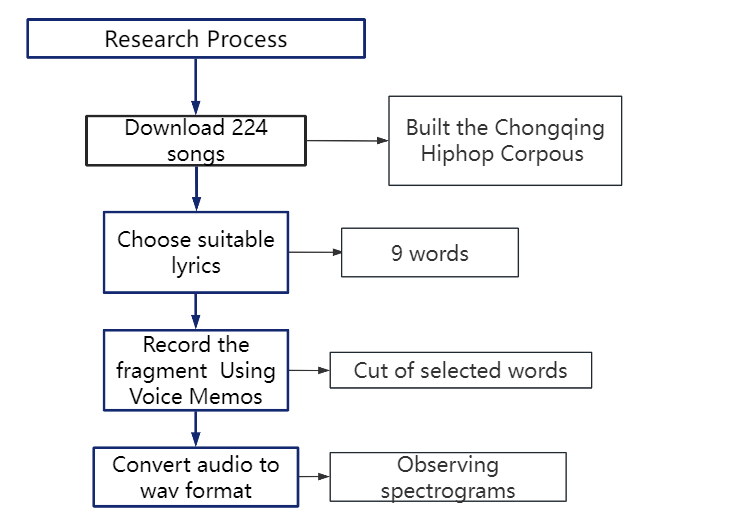A Praat-Based Study on the Vowel Features in Chongqing Hip-Hop Lyrics
Abstract
Chongqing dialect, having experienced the waves of ethnic migration, has given birth to distinctive linguistic features. Since the 1980s, academic research on the Chongqing dialect has gradually increased. However, most studies have only scratched the surface in terms of vocabulary, semantics, and phonological characteristics, with few attempts to delve into its internal phonetic structure. This study addresses this gap by using Praat software and theories of tongue position and formants to analyze rhyme vowels in Chongqing hip-hop lyrics. It examines formant frequencies (F1, F2, F3), pitch, and duration of vowels from local hip-hop artists' works. Results reveal that these vowels have distinct regional acoustic characteristics, differing from standard Mandarin, with lower formant frequencies aligning with the dialect's low-pitched nature. In addition, the study confirmed the phonetic changes that occurred in the 1970s, such as /ɤ/ → /ɛ/, /aʊ/, /uɔ/. This research enriches our understanding of Chongqing dialect's acoustic features and offers new insights for interdisciplinary studies in dialect phonetics and music linguistics.
Downloads
References
[2] Wang, J. J. (2018). The Rap of China and the cultural politics of hip-hop. Literary and Art Studies, (6), 113–123.
[3] Yang, Y. L., & Feng, Y. Q. (2020). "Authenticity" construction: Cultural production of symbols and meanings in vertical music variety shows. Modern Communication (Journal of Communication University of China), (5), 99–104.
[4] Fan, J. Y. (1979). The differentiation of the character "Xia (下)" in Chongqing dialect. Dialects, (7).
[5] Huang, X. Z. (1986). The classification of Southwestern Mandarin. Dialects, (12).
[6] Zhu, Y. K. (1987). On lexical differences in Chinese dialects. Journal of Shantou University, (10).
[7] Yang, H. M. (1995). The evolution of Chongqing phonology over the past forty years. Journal of Chongqing Education College, (3).
[8] Zeng, X. Y. (2013). A comparative analysis of Chongqing dialect system over the past 70 years. Journal of Chongqing Radio and Television University, (2).
[9] Li, Y. H. (2021). A study on dialect phonetics in Bashu local chronicles [Master’s thesis, Southwest Jiaotong University].
[10] Zhong, C. S. (2019). Cross-linguistic forensic speech comparison based on vowel formants. Foreign Languages (Journal of Shanghai International Studies University), (1), 61–71.
[11] Huang, Z. H. (2018). The impact of formants on the intelligibility of Uyghur speech. In Proceedings of the 2018 National Acoustics Conference (pp. 4–5). College of Information Science and Engineering, Xinjiang University.
[12] Cao, C. Y., Xie, Y. L., & Zhang, J. S. (2018). The influence of vowels on tone perception under different formant distribution. Journal of Tsinghua University (Science and Technology), (4), 352–356. https://doi.org/10.16511/j.cnki.qhdxxb.2018.04.008
[13] Delattre, P. (1951). The physiological interpretation of sound spectrograms. PMLA, 66(5), 864–875. https://doi.org/10.2307/459529
[14] Joos, M. (1948). Acoustic phonetics. Language, 24(2), 5–136. https://doi.org/10.2307/522229
[15] Wang, L. (1985). A history of Chinese phonology. China Social Sciences Press.
[16] Abramson, A. S., & Whalen, D. H. (2017). Voice Onset Time (VOT) at 50: Theoretical and practical issues in measuring voicing distinctions. Journal of Phonetics, 63, 75–86. https://doi.org/10.1016/j.wocn.2017.05.002


This work is licensed under a Creative Commons Attribution 4.0 International License.
Copyright for this article is retained by the author(s), with first publication rights granted to the journal.
This is an open-access article distributed under the terms and conditions of the Creative Commons Attribution license (http://creativecommons.org/licenses/by/4.0/).









1.png)









1.png)











